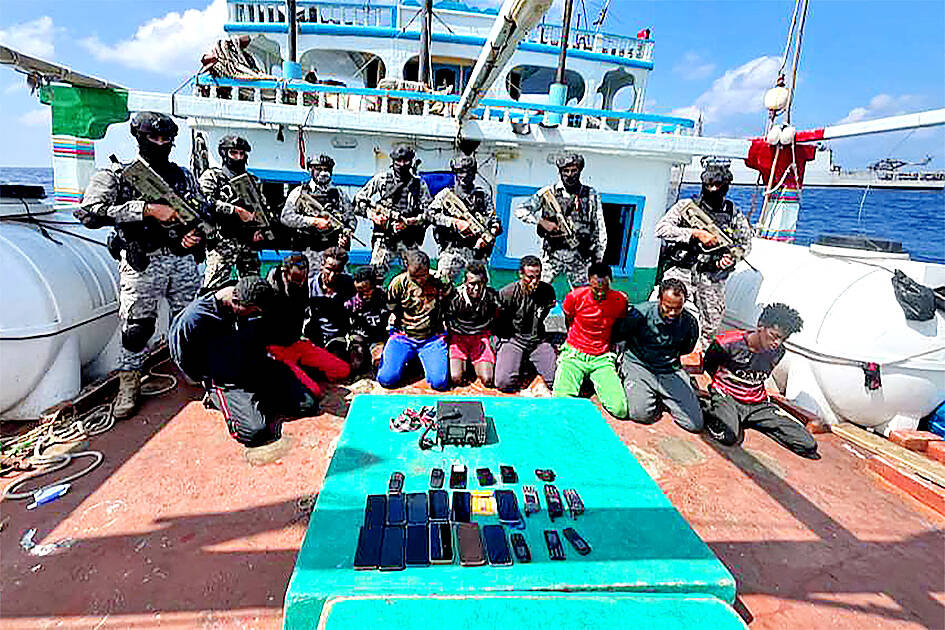The daring attack in December last year bore unsettling hallmarks of the piracy that once terrorized global shipping off eastern Africa: a cargo vessel hijacked, its crew taken to Somalia, and disappeared.
The capture of the foreign vessel was the first by pirates off Somalia since 2017, and follows a spike in armed seaborne attacks around the Horn of Africa not seen in years.
Analysts caution that the piracy poses nowhere near the threat it did in 2011, when navies around the world had to deploy warships to beat back the scourge and restore order at sea.

Photo: AFP / Indian Navy
However, this recent upswing in pirate activity has raised further concerns about marine security and shipping at a time when crucial trade corridors off Yemen have come under siege.
The UK Marine Trade Operations, which monitors piracy, recorded six incidents off Somalia’s coast since mid-December last year, from approaches by crews armed with machine guns and rocket launchers, to hijackings.
The Maritime Information Cooperation and Awareness (MICA) Center, a French maritime security agency, noted the “possible resurgence” of piracy off Somalia in a report last year.
It recorded nine attacks over last year, describing the number as “novel.”
Many of these incidents occurred off Puntland, the historic hub of piracy in the region. The northern state wraps around the Horn of Africa and boasts long coastlines on the Gulf of Aden and the Indian Ocean.
MICA Center commander Eric Jaslin said the increase occurred “almost simultaneously” as Yemen-based Houthi rebels began targeting boats headed for Israel in retaliation for the war in Gaza between Israel and Hamas.
“Almost at the same time, we began to observe a phenomena of piracy against dhows off the coast of Puntland,” Jaslin said, referring to the traditional wooden fishing boats that sail the Indian Ocean.
A number of dhow hijackings last year raised the possibility that dormant crews in the region could be “re-equipping” for attacks further out at sea, Institute for Security Studies researcher Timothy Walker said.
Pirates have traditionally sought to capture a “mother ship” — a motorized dhow or fishing trawler — capable of sailing greater distances where they can target larger vessels.
Since the Houthi attacks, many cargo ships have slowed down hundreds of miles out at sea to await instructions on whether to proceed to the Red Sea, Walker said.
“It creates a hunting ground,” he said.
These ships have become especially vulnerable as some foreign navies have relocated from the Indian Ocean to the Red Sea in response to the Houthi attacks, analysts say.
Local conditions in Somalia have also allowed pirates to regroup.
State elections in Puntland over December last year and last month meant some coastal security positions were vacated, International Crisis Group researcher Omar Mahmood said.
“These two reasons — on land and offshore — provided an opportunity for these criminal networks that have always been there,” he said.
The Puntland Marine Police Force did not respond to requests for comment.
In Eyl, a traditional pirate stronghold on Puntland’s east coast, locals say fishing trawlers from Southeast Asia, Iran and Europe plundering seas off Somalia have stirred anger in coastal communities.
“The reason why the pirates are re-emerging is because of the widespread illegal fishing on the coast,” said Ahmed Abdi Nuh, an elder from Eyl.
These attacks could still constitute piracy under global definitions and have surfaced time and again, experts say.
“A lot of justification for the pirates who were captured in the past was a kind of Robin Hood argument — that they were actually preventing illegal fishing,” Walker said.
Between Jan. 29 and Feb. 2, four fishing boats were freed by the Indian and Seychellois navies after being hijacked, sometimes more than 800 nautical miles (1,482km) from the coast.
“The further away from Somalia, the less likelihood for a connection to a fishing scenario,” said Hans Tino Hansen, CEO of Danish maritime intelligence and security company Risk Intelligence.
Analysts played down fears the bad days of piracy off Somalia were back, stressing that the presence of foreign navies had deterred once-wanton criminality at sea.
The overall number of piracy attacks has fallen sharply from a 2011 peak, when internal chaos in Somalia, and the absence of a coast guard, allowed pirates to hijack commercial ships and hold crews for ransom.
Since then a multinational naval force from as far afield as Japan, the UK and Brazil has brought muscle to patrols around Somalia, blunting this once-lucrative trade.
Compared with the early 2000s, navies have advanced systems for detecting pirate activity and merchant ships are more aware of the risks and familiar with security procedures.
Before the hijacking of the Maltese-flagged bulk carrier MV Ruen on Dec. 14, no cargo vessel had been boarded by pirates in the region since 2017, and before that 2012.
The recent uptick in pirate activity was “more likely to be a flare-up than full-fledged resurgence,” Mahmood said.
In Eyl, locals were doubtful too.
“There are warships patrolling the sea. I don’t believe any pirate in their right mind would take the chance,” said Ahmed Siyad, a fisher in Eyl.

To many, Tatu City on the outskirts of Nairobi looks like a success. The first city entirely built by a private company to be operational in east Africa, with about 25,000 people living and working there, it accounts for about two-thirds of all foreign investment in Kenya. Its low-tax status has attracted more than 100 businesses including Heineken, coffee brand Dormans, and the biggest call-center and cold-chain transport firms in the region. However, to some local politicians, Tatu City has looked more like a target for extortion. A parade of governors have demanded land worth millions of dollars in exchange

An Indonesian animated movie is smashing regional box office records and could be set for wider success as it prepares to open beyond the Southeast Asian archipelago’s silver screens. Jumbo — a film based on the adventures of main character, Don, a large orphaned Indonesian boy facing bullying at school — last month became the highest-grossing Southeast Asian animated film, raking in more than US$8 million. Released at the end of March to coincide with the Eid holidays after the Islamic fasting month of Ramadan, the movie has hit 8 million ticket sales, the third-highest in Indonesian cinema history, Film

Taiwan Semiconductor Manufacturing Co’s (TSMC, 台積電) revenue jumped 48 percent last month, underscoring how electronics firms scrambled to acquire essential components before global tariffs took effect. The main chipmaker for Apple Inc and Nvidia Corp reported monthly sales of NT$349.6 billion (US$11.6 billion). That compares with the average analysts’ estimate for a 38 percent rise in second-quarter revenue. US President Donald Trump’s trade war is prompting economists to retool GDP forecasts worldwide, casting doubt over the outlook for everything from iPhone demand to computing and datacenter construction. However, TSMC — a barometer for global tech spending given its central role in the

Alchip Technologies Ltd (世芯), an application-specific integrated circuit (ASIC) designer specializing in server chips, expects revenue to decline this year due to sagging demand for 5-nanometer artificial intelligence (AI) chips from a North America-based major customer, a company executive said yesterday. That would be the first contraction in revenue for Alchip as it has been enjoying strong revenue growth over the past few years, benefiting from cloud-service providers’ moves to reduce dependence on Nvidia Corp’s expensive AI chips by building their own AI accelerator by outsourcing chip design. The 5-nanometer chip was supposed to be a new growth engine as the lifecycle